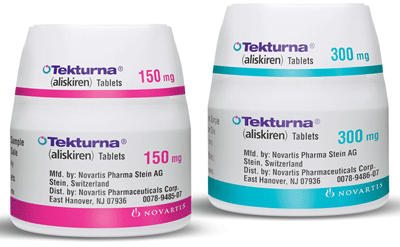Product
Tekturna
Approval Date
March 5, 2007
Release Date
March 28, 2007
Company
Novartis
Class
Antihypertensive agent (direct renin inhibitor)
Indication
Treatment of hypertension, as monotherapy or combined withother antihypertensive agents.
Active Ingredient
Aliskiren 150mg, 300mg; tabs.
Agency Roster
Deutsch (consumer)
Integrated Communications (professional)
Euro RSCG Life x2 (medical education)
MarketingStrategy/Execution
Novartis wasfirst to the USmarket with an oral renin inhibitor, Tekturna. Known as Rasilez abroad, thedrug also has been approved in the EU and in Switzerland. Analysts haveestimated peak sales of between $2.5 billion to $3.5 billion for the pill,which research shows lowers blood pressure better than other commonly-used BPmedicines, like ACE inhibitors and certain diuretics. Evidence suggests it’s alsouseful in combination, although not necessarily with Novartis’ own leading angiotensinreceptor blocker Diovan—something that could hamper sales. Another unknown is how the Swiss firm’s recentdecision to lay off some 1,260 sales and marketing posts will impact Tekturna’srollout.
The Market
| Antihypertensives US sales ($000s) last 5 years | |
| 2006 | $19,131,362 |
| 2005 | $17,677,634 |
| 2004 | $16,476,787 |
| 2003 | $14,990,286 |
| 2002 | $14,239,303 |
| Source: IMS Health, Oct. 2007 |
|
| Top 5 antihypertensives | ||
| Jan.-June ’07 US sales ($000s) | % sales growth over Jan.-June ‘06 | |
| COREG (GlaxoSmithKline) | $859,802 | 15% |
| NORVASC (Pfizer) |
$799,171 | -41% |
| TOPROL-XL (AstraZeneca) | $760,938 | -10% |
| LOTREL (Novartis) | $754,670 | 2% |
| DIOVAN (Novartis) |
$695,663 | 15% |
| Source: IMS Health, Oct. 2007 |
||
Physician Outlook
Tekturna is a new class of anti-hypertensive, offeringdirect renin inhibition. As a new class, both specialists and PCPs areextremely interested in trying it, hoping for better efficacy and tolerabilityfor their patients, not only as monotherapy but in combination with currentanti-hypertensives as well. Current anti-hypertensive classes have theadvantages of familiarity and long-term data in treating a variety ofcardiovascular co-morbidities and reducing cardiovascular risk. Tekturnamay enjoy a lively uptake as physician “give it a try,” but it may not become amajor force until this long-term data becomes available.
—Edwin Rupert, senior consultant, GfK V2, October 2007
Also in the Pipeline(according to Adis R&D Insight)
No competitor compounds in phase III or pre-registration, US
Recent MM&MCoverage
NovartisBP drug sees approval in Europe
Antidote
Productnews from the 03/06/07 news brief
Novartisasks FDA for Galvus review extension
FDAdelays approval of Novartis’ Galvus
Novartisgets FDA nod for blood-pressure pill
Force in the Field
TheTop 50: Integrated Communications
The Top 60: ICC
Pipeline 2007
Studyshows Galvus less effective than generic: Novartis
People news
Pharmacology
Aliskiren is an orally active, nonpeptide, potent directrenin inhibitor that decreases plasma renin activity (PRA) and inhibits theconversion of angioten-sinogen to angiotensin I. Unlike ACE inhibitors andangiotensin receptor blockers, whose effects suppress the negative feed-backloop leading to a compensatory rise in plasma renin concentration, aliskirenblocks the effect of increased renin levels so that PRA, angiotensin I andangiotensin II are reduced.
Aliskiren may be administered with other antihypertensive agents,however it is not known whether additive effects are present when aliskiren isused with ACE inhibitors or beta blockers.
Clinical Trials
The efficacy of aliskiren was evaluated in six randomized, double-blind,placebo-controlled 8-week trials involving patients with mild-to-moderatehypertension. Approximately 2,730 patients were given doses of 75–600mg of aliskirenand 1,231 patients were given placebo. Patients taking aliskiren showedreasonable blood pressure lowering effect at 150–300mg with no further increasein effect at 600mg. A substantial portion of effect was observed within 2 weeksof treat-ment. Patients in these trials continued open-label aliskiren for upto one year. A persistent BP lowering effect was seen by a randomizedwithdrawal study (patients randomized to continue drug or placebo), whichshowed a statistically significant difference between patients kept onaliskiren and those given placebo.
Aliskiren was also evaluated in combination with otherantihypertensives. In these studies, BP reductions when used in combinationwith hydrochlorothiazide or valsartan were greater than the reductions seenwith either aliskiren, HCTZ, or valsartan monotherapy. Aliskiren 150mg, whenadministered with amlodipine 5mg provided additional BP reduction, however thecombination was not statistically significantly better than amlodipine 10mg.Aliskiren has not been studied in combination with maximal doses of ACEinhibitors.
Adverse Reactions
Diarrhea, hypotension, cough, rash, edema, elevated uricacid, gout, renal stones; rare: angioedema.
Adults
=18yrs: initially 150mg once daily, may increase to 300mg oncedaily if BP not adequately controlled. May be given with otherantihypertensives (see literature).
Children
< 18yrs: not recommended
Precautions
Moderate to severe renal dysfunction. History of dialysis.Nephrotic syndrome. Renovascular hypertension. Correct salt/volume depletionbefore starting therapy or start under close supervision. Monitor forhyperkalemia in diabetics. Pregnancy (Cat.C in 1st trimester; Cat.D 2nd and 3rdtrimesters); discontinue as soon as pregnancy detected. Nursing mothers: notrecommended.
Interactions
Decreases furosemide plasma levels; may have diminishedeffect. Potentiated by atorvastatin, ketoconazole. Antagonized by irbesartan.Caution with max doses of ACE inhibitors.









